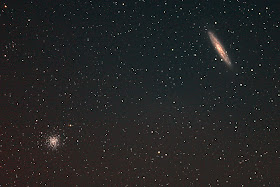 We got out there about sunset and boy, did it cool down quickly! I was running 2 cameras, one on a small telescope and the other on a tracking mount, so was a blur setting up equipment. Melinda set up her 5" Celestron for visual observing. As it was about to get dark, I saw how photogenic the alignment was in the west so tried combining a few exposures with self-portraits, using the on-camera flash to light us up. This image is my favorite. Moon, Venus and Jupiter in order from brightest to faintest...
We got out there about sunset and boy, did it cool down quickly! I was running 2 cameras, one on a small telescope and the other on a tracking mount, so was a blur setting up equipment. Melinda set up her 5" Celestron for visual observing. As it was about to get dark, I saw how photogenic the alignment was in the west so tried combining a few exposures with self-portraits, using the on-camera flash to light us up. This image is my favorite. Moon, Venus and Jupiter in order from brightest to faintest... My observing program was to get a fairly deep exposure on the constellation Taurus. On one of the astro-photo groups, T. Wade Earle posted a CCD shot (like a digital camera, but with higher sensitivity and a dedicated cooling system) that is shown here. The entire area east of the Pleiades and the California Nebula (named for it's shape) is full of dark nebulae and
My observing program was to get a fairly deep exposure on the constellation Taurus. On one of the astro-photo groups, T. Wade Earle posted a CCD shot (like a digital camera, but with higher sensitivity and a dedicated cooling system) that is shown here. The entire area east of the Pleiades and the California Nebula (named for it's shape) is full of dark nebulae and  molecular clouds. My effort (also shown here) is not as deep, but is starting to show the combination of dark and diffuse nebulosity. I'm still exposing far less than Wade was, so may add more to the exposure - my exposure was 35 minutes with the Canon 20Da and 50mm lens at F/2.8.
molecular clouds. My effort (also shown here) is not as deep, but is starting to show the combination of dark and diffuse nebulosity. I'm still exposing far less than Wade was, so may add more to the exposure - my exposure was 35 minutes with the Canon 20Da and 50mm lens at F/2.8. While this was going on, I was also shooting a little Meade 80mm F/6 lens on a couple objects. My first target was the dual object NGC 253 and 288. The former is a galaxy only 10 million light years away (close for galaxies!) and the cluster is only 28,000 light years away, part of our own Milky Way galaxy. This image is added from 10 exposures of 6 minutes each with the Canon XSi, so totals an hour of exposure. There is a little gradient at the bottom (sort of a reddish glow) that needs correction, but wanted to get it on the blog!
While this was going on, I was also shooting a little Meade 80mm F/6 lens on a couple objects. My first target was the dual object NGC 253 and 288. The former is a galaxy only 10 million light years away (close for galaxies!) and the cluster is only 28,000 light years away, part of our own Milky Way galaxy. This image is added from 10 exposures of 6 minutes each with the Canon XSi, so totals an hour of exposure. There is a little gradient at the bottom (sort of a reddish glow) that needs correction, but wanted to get it on the blog! The last shot with the little Meade scope is a quick series on the Pleiades - 5 exposures of 2.5 minutes each. The cluster is young (only 100 million years or so), and is close by (and easily visible to the naked eye as a diffuse cloud in the east this time of year) at about 440 light years. It was once thought that the diffuse nebulosity in the photo was leftover gas from formation of the cluster, but is now thought the motion of the cluster happens to bring it through the gas cloud.
The last shot with the little Meade scope is a quick series on the Pleiades - 5 exposures of 2.5 minutes each. The cluster is young (only 100 million years or so), and is close by (and easily visible to the naked eye as a diffuse cloud in the east this time of year) at about 440 light years. It was once thought that the diffuse nebulosity in the photo was leftover gas from formation of the cluster, but is now thought the motion of the cluster happens to bring it through the gas cloud.It was a fun night, but cold, so we didn't mind closing up early so that we could be in bed by midnight - it was a "school" night, after all!
No comments:
Post a Comment
We value your comments, but no spammers, please!